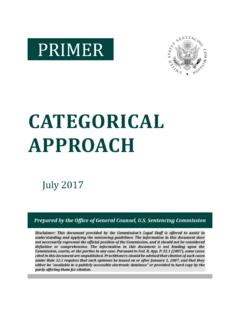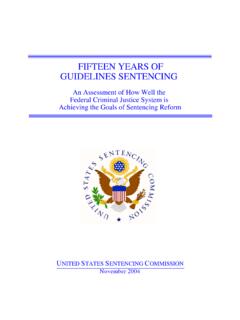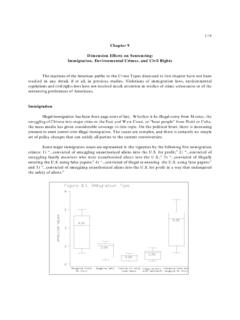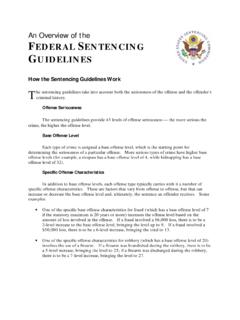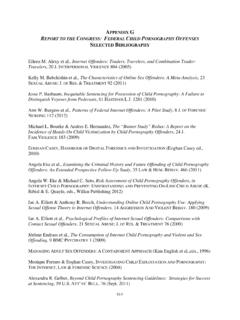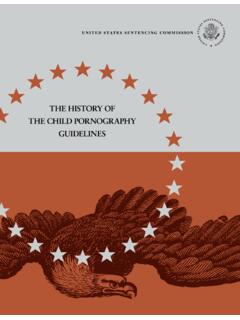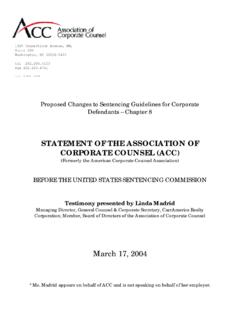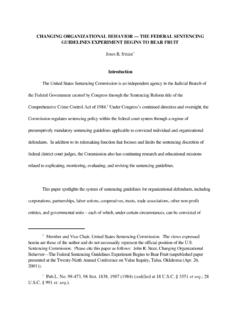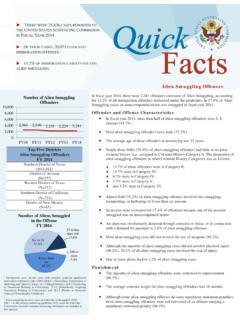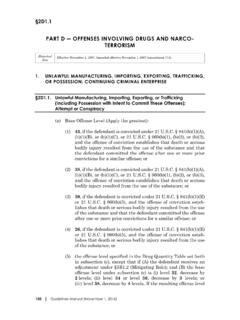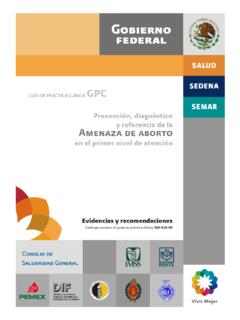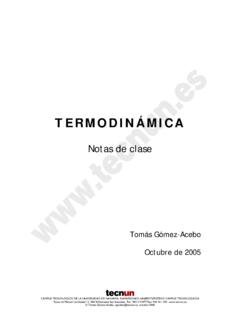Transcription of Departure and Variance Primer - United States Sentencing ...
1 Departure and Variance Primer Prepared bythe Office of General Sentencing CommissionMay 2014 Disclaimer: This document provided by the Commission s Legal Staff is offered to assist in understanding and applying the sentencingguidelines. The information in this document does not necessarily represent the official position of the Commission, and it should not beconsidered definitive or comprehensive. The information in this document is not binding upon the Commission, courts, or the parties in anycase. Pursuant to Fed. R. App. P. (2007), some cases cited in this document are unpublished. Practitioners should be advised that citationof such cases under Rule requires that such opinions be issued on or after January 1, 2007, and that they either be available in apublicly accessible electronic database or provided in hard copy by the party offering them for OF of the Sentencing of Sentences on Four, Part A Criminal History Departures Five, Part K Departures: Substantial Assistance to of Court Five, Part K Departures: Other Grounds for Grounds for Grounds for Grounds for Examples of Departure Crimes and Sex and Prohibitions Applicable to all grounds for of Specific Reasons for 3553(A) 3553(a)(1).
2 S Criminal of the s Health Nature of the 3553(a)(2).. to Protect the Public from Further to Provide Just Punishment for the to Reflect the Seriousness of the 3553(a)(3).. 3553(a)(4), (5).. 3553(a)(6).. 3553(a)(7).. of the 3553(a) BASED ON POLICY DISAGREEMENT WITH THE AND Variance PRIMERThis Primer contains a summary of guideline provisions and annotations to judicialopinions addressing some of the most commonly applied grounds for Departure . It also addressesissues relating to variances outside the guideline range. The document was developed to helpjudges, lawyers, and probation officers locate relevant authorities when applying the federalsentencing guidelines.
3 It does not include all authorities needed to correctly apply the guidelines, and is not a substitute for reading and interpreting the Guidelines Manual, statutes, and case PRINCIPLESU nless otherwise prohibited by law, a Sentencing court may consider without limitationany information concerning the background, character, and conduct of a defendant. Such1information may be considered when imposing a sentence within the applicable guideline rangeand whether and to what extent to sentence outside the guideline range. A court may impose a2sentence outside the properly calculated guideline range through either a Departure or a Variance . A Departure is either (i) the imposition of a sentence outside the guideline range or asentence that is otherwise different from the guideline sentence or, for purposes of (Departures Based on Inadequacy of Criminal History Category), (ii) assignment of a criminalhistory category other than the otherwise applicable criminal history category, in order to effect asentence outside the applicable guideline range.
4 3A Variance is a sentence imposed outside the applicable guideline range based upon thestatutory Sentencing factors found at 18 3553(a). As explained by the Ninth Circuit:A Departure is typically a change from the final Sentencing range computed byexamining the provisions of the Guidelines themselves. It is frequently triggeredby a prosecution request to reward cooperation .. or by other factors that take thecase outside the heartland contemplated by the Sentencing Commission when itdrafted the Guidelines for a typical offense. A Variance , by contrast, occurswhen a judge imposes a sentence above or below the otherwise properlycalculated final Sentencing range based on application of the other statutory See (Information to be Used in Imposing Sentence (Selecting a Point Within the Guideline Range or1 Departing from the Guidelines)).
5 See also 18 3661 (Use of Information for Sentencing ). One limitation onthe information used is where the defendant agrees to cooperate with the government and as part of an agreement thegovernment agrees that self-incriminating evidence will not be used against the defendant. See (Use ofCertain Information). See , comment. (backg d.).2 See (Application Instructions), comment. ( (E)). 31factors in 18 3553(a). OF THE Sentencing COURTA Sentencing court must follow the three-step process set forth by Gall v. United States . 5 First, the court must properly determine the guideline range. Second, the court must determine6whether to apply any of the guidelines Departure policy statements to adjust the guideline , the court must consider all the factors set forth in 18 3553(a) as a whole,including whether a Variance a sentence outside the advisory guideline system is warranted.
6 REQUIREMENTSB efore departing from the standard guideline range, reasonable notice must be given tothe of nature of that Departure unless the grounds are identified in the presentence report or aparty s prehearing submission. Advance notice of a Variance is not required by rule. However,910 United States v. Rangel, 697 795, 801 (9th Cir. 2012) cert. denied, 133 S. Ct. 1294 ( 2013) citing United4 States v. Cruz-Perez, 567 1142, 1146 (9th Cir. 2009). 552 38 (2007) (the district court should begin all Sentencing proceedings by correctly calculating the5applicable guideline range, and that to secure nationwide consistency, the Guidelines should be the starting pointand the initial benchmark ).
7 See also USSG (a)-(c) (Application Instructions). Id.; 18 3553(a)(4).6 Id.; 18 3553(a)(5). See also United States v. McBride, 434 470 (6th Cir. 2006) (guideline7departures are still a relevant consideration for determining the appropriate guideline sentence); United States , 418 1212 (11th Cir. 2005) ( the application of the guidelines is not complete until the departures, if any,that are warranted are appropriately considered ); see also United States v. Lofink, 564 232 (3d Cir. 2009)(district court s failure to rule on the defendant s Departure arguments constitutes procedural error). But see UnitedStates v. Johnson, 427 423 (7th Cir. 2005) (defendant s framing of the issue as one about departures hasbeen rendered obsolete by our recent decisions applying Booker.)
8 It is now clear that after Booker what is at stakeis the reasonableness of the sentence, not the correctness of the departures as measured against pre-Bookerdecisions that cabined the discretion of Sentencing courts to depart from guidelines that were then mandatory ); United States v. Mohammed, 459 979 (9th Cir. 2006) (in light of Booker, circuit would treat such so-calleddepartures as an exercise of post-Booker discretion to sentence a defendant outside of the applicable guidelinesrange and subject it to a unitary review for reasonableness, no matter how the district court styles its sentencingdecision ); see also United States v. Brown, 578 221 (3d Cir. 2006) (vacating and remanding where districtcourt failed to distinguish whether above guideline sentence was product of a Departure or a Variance ); United Statesv.
9 Miller, 479 984 (8th Cir. 2007) (conflating Departure considerations and the Variance analysis can beharmless error where the ultimate sentence is not unreasonable). See (c); See also United States v. Hughes, 401 540, 546 (4th Cir. 2005); United States v. Stone, 651, 655 (6th Cir. 2005); United States v. Talley, 431 784, 786 (11th Cir. 2005). Rule 32(h), Federal Rules of Criminal Procedure. See also (Notice of Possible Departure (Policy9 Statement)); Burns v. United States , 501 129 (1991); United States v. Dozier, 444 1215 (10th Cir. 2006). But see United States v. Walker, 447 999 (7th Cir. 2006) (because Seventh Circuit precedent has declared the( )2[s]ound practice dictates that judges in all cases should make sure that theinformation provided to the parties in advance of the hearing, and in the hearingitself, has given them an adequate opportunity to confront and debate the relevantissues.)
10 We recognize that there will be some cases in which the factual basis for aparticular sentence will come as a surprise to a defendant or the Government. The more appropriate response to such a problem is not to extend the reach of Rule32(h) s notice requirement categorically, but rather for a district judge to considergranting a continuance when a party has a legitimate basis for claiming that thesurprise was OF SENTENCES ON APPEALA ppellate courts use a two-step process to review federal sentences. First, they ensure12that the district court committed no significant procedural error, such as failing to calculate (orimproperly calculating) the Guidelines range. Second, they consider the substantivereasonableness of the sentence imposed under an abuse-of-discretion standard, taking intoaccount the totality of the circumstances, including the extent of any Variance from the guidelinerange.
